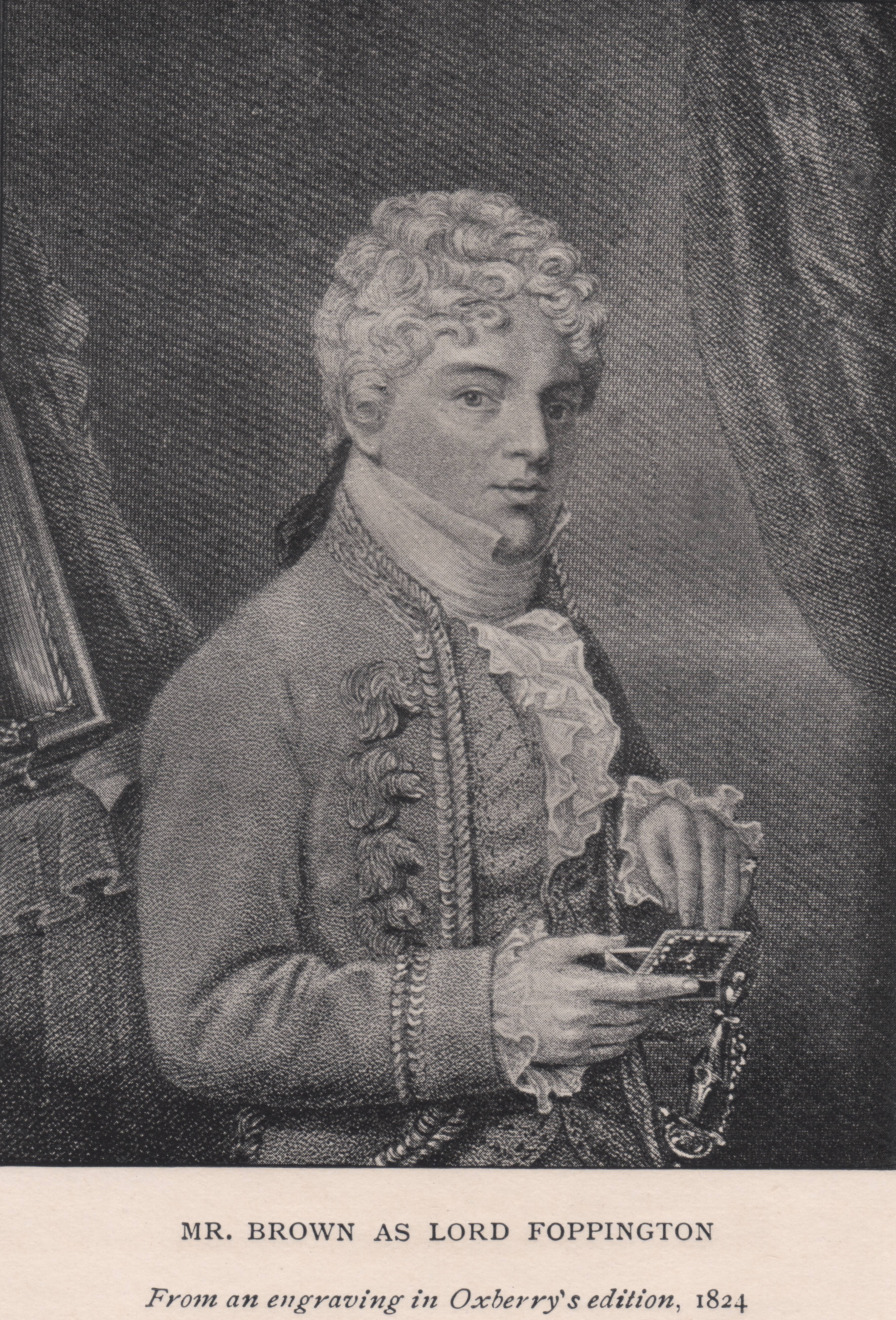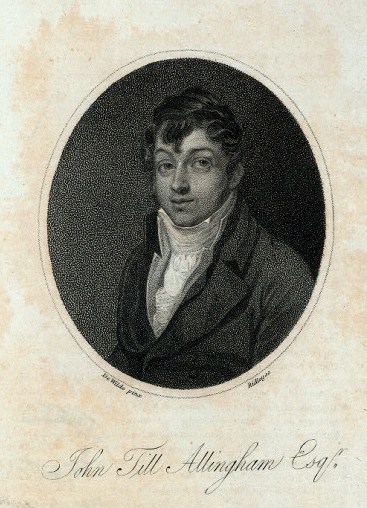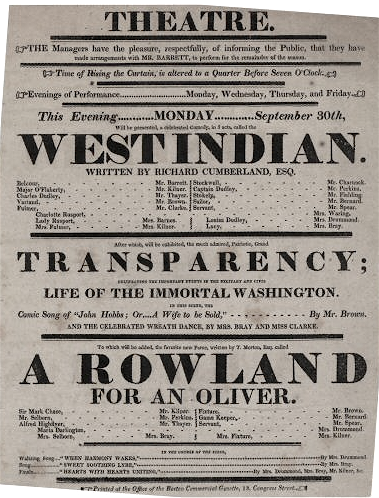|
Samuel Simmons (actor)
Samuel Simmons (1777? – 1819) was an English actor. Biography Simmons was born in London about 1777. He is first heard of at Covent Garden on 21 September 1785, when, as ‘Master’ Simmons, he played the Duke of York in Colley Cibber's ‘Richard III,’ and showed promise. On 21 November following he was Tom Thumb. He is said to have also played the boy in Henry Carey's ‘Contrivances,’ the page in the ‘Orphan’ and other juvenile characters. He soon disappears from ken to return as a man to the same house on 5 November 1796 as the original Momus, a part rejected by Fawcett, in John O'Keeffe's ‘Olympus in an Uproar.’ On the 19th he was the first Dicky, a keeper in the king's bench, in Joseph George Holman's ‘Abroad and at Home.’ The Puritan in ‘Duke and No Duke,’ Endless in ‘No Song no Supper’ followed, and he was on 25 April 1797 the original Premiss, a lawyer, in Hoare's ‘Italian Villagers.’ From this time until his death he remained at Covent Gar ... [...More Info...] [...Related Items...] OR: [Wikipedia] [Google] [Baidu] |
London
London is the capital and largest city of England and the United Kingdom, with a population of just under 9 million. It stands on the River Thames in south-east England at the head of a estuary down to the North Sea, and has been a major settlement for two millennia. The City of London, its ancient core and financial centre, was founded by the Romans as '' Londinium'' and retains its medieval boundaries.See also: Independent city § National capitals The City of Westminster, to the west of the City of London, has for centuries hosted the national government and parliament. Since the 19th century, the name "London" has also referred to the metropolis around this core, historically split between the counties of Middlesex, Essex, Surrey, Kent, and Hertfordshire, which largely comprises Greater London, governed by the Greater London Authority.The Greater London Authority consists of the Mayor of London and the London Assembly. The London Mayor is distinguished fr ... [...More Info...] [...Related Items...] OR: [Wikipedia] [Google] [Baidu] |
Henry V (play)
''Henry V'' is a history play by William Shakespeare, believed to have been written near 1599. It tells the story of King Henry V of England, focusing on events immediately before and after the Battle of Agincourt (1415) during the Hundred Years' War. In the First Quarto text, it was titled ''The Cronicle History of Henry the fift'', and ''The Life of Henry the Fifth'' in the First Folio text. The play is the final part of a tetralogy, preceded by '' Richard II'', ''Henry IV, Part 1'', and '' Henry IV, Part 2''. The original audiences would thus have already been familiar with the title character, who was depicted in the ''Henry IV'' plays as a wild, undisciplined young man. In ''Henry V'', the young prince has matured. He embarks on an expedition to France and, his army badly outnumbered, defeats the French at Agincourt. Characters * Chorus The English * King Henry V * Duke of Gloucester – Henry's brother * Duke of Bedford – Henry's brother * Duke of Clarence – He ... [...More Info...] [...Related Items...] OR: [Wikipedia] [Google] [Baidu] |
Romeo And Juliet
''Romeo and Juliet'' is a Shakespearean tragedy, tragedy written by William Shakespeare early in his career about the romance between two Italian youths from feuding families. It was among Shakespeare's most popular plays during his lifetime and, along with ''Hamlet'', is one of his most frequently performed plays. Today, the Title character, title characters are regarded as archetype, archetypal young lovers. ''Romeo and Juliet'' belongs to a tradition of tragic Romance (love), romances stretching back to Ancient history, antiquity. The plot is based on an Italian tale translated into verse as ''The Tragical History of Romeus and Juliet'' by Arthur Brooke (poet), Arthur Brooke in 1562 and retold in prose in ''Palace of Pleasure'' by William Painter (author), William Painter in 1567. Shakespeare borrowed heavily from both but expanded the plot by developing a number of supporting characters, particularly Mercutio and Count Paris, Paris. Believed to have been written between ... [...More Info...] [...Related Items...] OR: [Wikipedia] [Google] [Baidu] |
Trip To Scarborough
''A Trip to Scarborough'' is an 18th-century play by Richard Brinsley Sheridan (1751–1816), first performed on 24 February 1777. Sheridan based his work on John Vanbrugh's ''The Relapse'' (1696), removing much of the bawdy content. The play was reworked as one of three plot strands in a 1982 revival by Alan Ayckbourn, with the action taking place in the Royal Hotel, Scarborough. The first performance was on 8 December that year. It is a technically demanding piece as the actors are required to take on several roles, with quick changes between scenes as the play switches from the 18th century to World War II to the present day. Ayckbourn updated the production when it returned to the Stephen Joseph Theatre in the town during 2007–2008. Plot The hero of the play, Tom Fashion, arrives penniless in Scarborough, attended by but one faithful servant, Lory, who privately informs the audience that he will never desert his master until he pays him his wages. Fashion has come to vi ... [...More Info...] [...Related Items...] OR: [Wikipedia] [Google] [Baidu] |
School For Scandal
''The School for Scandal'' is a comedy of manners written by Richard Brinsley Sheridan. It was first performed in London at Drury Lane Theatre on 8 May 1777. Plot Act I Scene I: Lady Sneerwell, a wealthy young widow, and her hireling Snake discuss her various scandal-spreading plots. Snake asks why she is so involved in the affairs of Sir Peter Teazle, his ward Maria, and Charles and Joseph Surface, two young men under Sir Peter's informal guardianship, and why she has not yielded to the attentions of Joseph, who is highly respectable. Lady Sneerwell confides that Joseph wants Maria, who is an heiress, and that Maria wants Charles. Thus she and Joseph are plotting to alienate Maria from Charles by putting out rumours of an affair between Charles and Sir Peter's new young wife, Lady Teazle. Joseph arrives to confer with Lady Sneerwell. Maria herself then enters, fleeing the attentions of Sir Benjamin Backbite and his uncle, Crabtree. Mrs. Candour enters and ironically talks ... [...More Info...] [...Related Items...] OR: [Wikipedia] [Google] [Baidu] |
John Till Allingham
John Till Allingham ( – 28 February 1812)John Till Allingham in the ''England & Wales, Non-Conformist and Non-Parochial Registers, 1567-1970'' was an English dramatist. Life Allingham was the son of a wine merchant in the City of London. He was brought up to the profession of the law, but is known as a successful and prolific dramatist. Allingham died aged 36, at his father's house in Islington, and was buried in March 1812 at Bunhill Fields. In his ''Life of John Kemble'' (1825), James Boaden suggested his early death was caused by drinking. Works Allingham's afterpiece, '' Fortune's Frolic'', first produced at Covent Garden Theatre in 1799, long enjoyed popularity, and the leading character Robin Roughhead wasplayed by celebrated actors. His second play, '' Tis all a Farce'', was produced at the Haymarket Theatre in 1800. Others of his works were: the '' Marriage Promise'', a comedy with music by Michael Kelly, produced at Drury Lane Theatre 1803; ''Mrs. Wiggins'', a farce ... [...More Info...] [...Related Items...] OR: [Wikipedia] [Google] [Baidu] |
The West Indian
''The West Indian'' is a play by Richard Cumberland first staged at the Drury Lane Theatre in 1771. A comedy, it depicts Belcour, a West Indian plantation-owner, travelling to Britain. Belcour tries to overcome his father's lingering disapproval of him and marry his sweetheart Louisa. Its hero, who probably owes much to the suggestion of Garrick, is a young scapegrace fresh from the tropics, "with rum and sugar enough belonging to him to make all the water in the Thames into punch," — a libertine with generous instincts, which prevail in the end. This early example of the modern drama was favorably received; Boden translated it into German, and Goethe acted in it at the Weimar court. The play was a success running for 28 performances in its original run and was Cumberland's most popular comic work. One of the Drury Lane staff observed "the success which has attended the performances of ''The West Indian'' has exceeded that of any comedy within the memory of the oldest man living ... [...More Info...] [...Related Items...] OR: [Wikipedia] [Google] [Baidu] |
Henry VIII (play)
''Henry VIII'' is a collaborative history play, written by William Shakespeare and John Fletcher, based on the life of Henry VIII. An alternative title, , is recorded in contemporary documents, with the title not appearing until the play's publication in the First Folio of 1623. Stylistic evidence indicates that individual scenes were written by either Shakespeare or his collaborator and successor, John Fletcher. It is also somewhat characteristic of the late romances in its structure. It is noted for having more stage directions than any of Shakespeare's other plays. During a performance of ''Henry VIII'' at the Globe Theatre in 1613, a cannon shot employed for special effects ignited the theatre's thatched roof (and the beams), burning the original Globe building to the ground. Characters * Prologue/Epilogue * Henry VIII – King of England * Cardinal Wolsey – Archbishop of York and Lord Chancellor; initially, Henry's chief adviser * Queen Katherine – later d ... [...More Info...] [...Related Items...] OR: [Wikipedia] [Google] [Baidu] |
Who Wants A Guinea?
''Who Wants a Guinea?'' is an 1805 comedy play by the British writer George Colman the Younger. It premiered at the Theatre Royal, Covent Garden in London on 18 April 1805. Less successful than his previous work ''John Bull'', it lasted for nine performances. The original cast included John Philip Kemble as Barford, Joseph Shepherd Munden as Torrent, William Chapman as Heartly, Charles Kemble as Henry, John Waddy as Hogmore, John Fawcett as Solomon Gundy, Samuel Simmons as Jonathon Oldskirt, William Thomas Lewis as Sir Larry Mac Murragh, John Emery as Andrew Bang, George Davenport as Carrydot, Maria Gibbs as Fanny and Isabella Mattocks as Mrs Glastonbury. The Irish premiere was at the Crow Street Theatre in Dublin Dublin (; , or ) is the capital and largest city of Republic of Ireland, Ireland. On a bay at the mouth of the River Liffey, it is in the Provinces of Ireland, province of Leinster, bordered on the south by the Dublin Mountains, a part of th ... on 25 May 1805. ... [...More Info...] [...Related Items...] OR: [Wikipedia] [Google] [Baidu] |
George Colman The Younger
George Colman (21 October 1762 – 17 October 1836), known as "the Younger", was an English dramatist and miscellaneous writer. He was the son of George Colman the Elder. Life He passed from Westminster School to Christ Church, Oxford, and King's College, University of Aberdeen, and was finally entered as a student of law at Lincoln's Inn, London. While in Aberdeen, he published a poem satirizing Charles James Fox, called ''The Man of the People.'' In 1782 he produced his first play, ''The Female Dramatist'',at his father's playhouse in the Haymarket. The failing health of the elder Colman obliged him to relinquish the management of the Haymarket theatre in 1789, when the younger George succeeded him, at a yearly salary of £600. On the death of the father the patent was continued to the son; however, difficulties arose, as he was involved in litigation with Thomas Harris and was unable to pay the expenses of the performances at the Haymarket. He was forced to take sanctuar ... [...More Info...] [...Related Items...] OR: [Wikipedia] [Google] [Baidu] |
Merry Wives Of Windsor
''The Merry Wives of Windsor'' or ''Sir John Falstaff and the Merry Wives of Windsor'' is a comedy by William Shakespeare first published in 1602, though believed to have been written in or before 1597. The Windsor of the play's title is a reference to the town of Windsor, also the location of Windsor Castle, in Berkshire, England. Though nominally set in the reign of Henry IV or early in the reign of Henry V, the play makes no pretence to exist outside contemporary Elizabethan-era English middle-class life. It features the character Sir John Falstaff, the fat knight who had previously been featured in ''Henry IV, Part 1'' and '' Part 2''. It has been adapted for the opera at least ten times. The play is one of Shakespeare's lesser-regarded works among literary critics. Tradition has it that ''The Merry Wives of Windsor'' was written at the request of Queen Elizabeth I. After watching ''Henry IV Part I'', she asked Shakespeare to write a play depicting Falstaff in love. Char ... [...More Info...] [...Related Items...] OR: [Wikipedia] [Google] [Baidu] |
Robert Shallow
Robert Shallow is a fictional character who appears in Shakespeare's plays '' Henry IV, Part 2'' and ''The Merry Wives of Windsor''. He is a wealthy landowner and Justice of the Peace in Gloucestershire, who at the time of ''The Merry Wives of Windsor'' is said to be over 80 ("four score years and upward"). A thin, vain and often self-deluding individual, used to life in the provinces, Shallow functions as a dramatic foil to the rotund and worldly Sir John Falstaff, who visits Shallow's lands on royal business, but later returns intending to fleece Shallow of his money. In the ''Merry Wives'' he visits Windsor with his relative Slender, encountering Falstaff once more. It has long been speculated that Shallow is a satire of Sir Thomas Lucy, a local landowner near Stratford-upon-Avon, with whom Shakespeare is said to have got into trouble as a young man. Other real-life models have also been proposed. ''Henry IV, Part 2'' In ''Henry IV, Part 2'' Falstaff is commissioned to ra ... [...More Info...] [...Related Items...] OR: [Wikipedia] [Google] [Baidu] |








